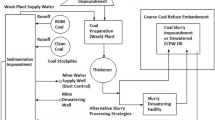Abstract
In China, coal mining wastes have traditionally been dumped in cone-shaped heaps that have the potential to pollute air, soil and water environments and landscapes through dust generation, leachate production, self-ignition and as a consequence of an absence of vegetation cover. Since 1980s, the disposal technique for coal mining wastes has been changing and in many instances the wastes are now transported directly to subsided land as a fill to enable the reuse of that land. Thus, today, both coal mining waste dumps from the past and filled subsided lands are in existence. However, the comparative impacts of these different disposal techniques on the environment and farmland productivity have not been studied in detail. Using Dongtan (DT), Nantun (NT) and Xinglongzhuang (XLZ) coal mines as examples, the components of coal mining wastes and their potential pollution contribution to soil, surface water and ground water are tested in-situ. The results show that contaminants are released after self-ignition and weathering of coal mining wastes, but they are not above the allowable environmental standards. However, despite these findings, more and closer attention needs to be paid to the mobility, transportation and accumulation of these contaminants in the environment over time.







Similar content being viewed by others
References
Bell FG, Stacey TR, Genske DD (2000) Mining subsidence and its effect on the environment: some differing examples. Environ Geol 40:135–152
Bian ZF, Zhang YP (2006) Land use changes in Xuzhou coal mining area (in Chinese). Acta Geographica Sinica 61:349–358
Caldwell JA, Moss ASE (1981) The simplified analysis of mine waste embankments. Symposium on design of non-impounding mine waste embankments. Denver USA. AIME Fall Meeting
Canibano JG (1995) Latest developments in the utilization of coal mining wastes. Coal Sci Technol 24:1629–1632
Creedy D, Wang L, Zhou X, Liu H, Campbell G (2006) Transforming China’s coal mines: a case history of the Shuangliu Mine. Nat Resour Forum 30:15–26
Driussi C, Jansz J (2005) Technological options for waste minimization in the mining industry. J Cleaner Prod
Earle AR, Robert E (1996) Environmental effects of mining. CRC Press, Boca Raton, pp 49–85
Ghose MK (2003) Indian small-scale mining with special emphasis on environmental management. J Cleaner Prod 11:159–165
Glauser S, McAllister ML, Milioli G (2005) The challenges of sustainability in mining regions: The coal mining region of Santa Catarina, Brazil. Nat Resour Forum 29:1–11
General Administration of Quality Supervision, Inspection and Quarantine of the P R China (GAoQSIQ) and Standardization Administration of the P R China (SA) 2005. Standards for Irrigation Water Quality, GB5084-2005
General Administration of Environmental Protection of the P R China (GAoEP) 2002. Environmental Quality Standards for Surface Water, GB3838-2002
General Administration of Environmental Protection of the P R China (GAoEP) and General Administration of Quality Supervision, Inspection and Quarantine of the P R China (GAoQSIQ) 2001. Standard for pollution control on the storage and disposal site for general industrial solid waste, GB 18599-2001
Gryczrnanski M (1997) Coal mining waste as a structural material in Polish civil and water engineering. Paper presented at: Proceedings of International Conference on Solid Waste Technology Management, pp l–8
Heynen JJM, Bolk H.NJA, Senden GJ, Tummers PJ (1994) Re-use of colliery spoils in construction materials using fluidized bed combustion. Environmental aspects of construction with waste materials. Elsevier Science B·V, Amsterdam, pp 655–664
Kwolek JK (1999) Aspects of geo-legal mitigation of environmental impact from mining and associated waste in the UK. J Geochem Explor 66:327–332
Li DX, Song XY, Gong CC, Pan ZH (2006) Research on cementitious behavior and mechanism of pozzolanic cement with coal gangue. Cement Concrete Res 36:1752–1759
Martinez RC, Belen F-S, Philip DP, Marıa JF-G (2007) Natural and man-induced revegetation on mining wastes: Changes in the floristic composition during early succession. Ecol Eng 30:286–294
McKinnon E (2002) The environmental effects of mining waste disposal at Lihir Gold Mine, Papua New Guinea. J Rural Remote Environ Health 1:40–50
Meck M, Love D, Mapani B (2006) Zimbabwean mine dumps and their impacts on river water quality—a reconnaissance study. Phys Chem Earth 31:797–803
Ministry of Health of the P R China (MoH) and Standardization Administration of the P R China (SA) 2006. Standards for drinking water quality, GB 5749-2006
National Administration of Environmental Protection (NAoEP) and National Administration of Technical Supervision (NAoTS) 1995. Environmental Quality Standards for Soils, GB 15618-1995
Romero A, Gonzalez I, Galan E (2006) Estimation of potential pollution of waste mining dumps at Pena del Hierro (Pyrite Belt, SW Spain) as a base for future mitigation actions. Appl Geochem 21:1093–1108
Sengupta M (1993) Environmental impacts of mining–monitoring, restoration and control. Lewis, London, pp 1–31
Siboni N, Fine M, BreslerV Loya Y (2004) Coastal coal pollution increases Cd concentrations in the predatory gastropod Hexaplex trunculus and is detrimental to its health. Mar Pollut Bull 49:111–118
Skarzynska KM (1995) Reuse of coal mining wastes in civil engineering—part 2: utilization of minestone. Waste Manage 15:83–126
Tiwary RK (2001) Environmental impact of coal mining on water regime and its management. Water Air Soil Pollut 132:185–199
Topuz E (1998) Feasibility of an integrated coal mining and waste disposal system. In: Pasamehmetoglu AG, Ozgenoglu A (eds) Environ. Issues Waste Manage. Energy Miner. Prod. Proceedings of 5th International Symposium, 1998, pp 531–542
Acknowledgments
The investigations were supported by Natural Scientific Fund of China with approved no. 50574095. The investigations were also supported by the 111 project with approved no. B07028, the project for PhD program with approved no. 20060290511, the project for new century talents with approved no. NCET-04-0487 and the project for authors of excellent Ph.D. dissertations with approved no. 200044 hosted by Ministry of Education of China.
Author information
Authors and Affiliations
Corresponding author
Rights and permissions
About this article
Cite this article
Bian, Z., Dong, J., Lei, S. et al. The impact of disposal and treatment of coal mining wastes on environment and farmland. Environ Geol 58, 625–634 (2009). https://doi.org/10.1007/s00254-008-1537-0
Received:
Accepted:
Published:
Issue Date:
DOI: https://doi.org/10.1007/s00254-008-1537-0




